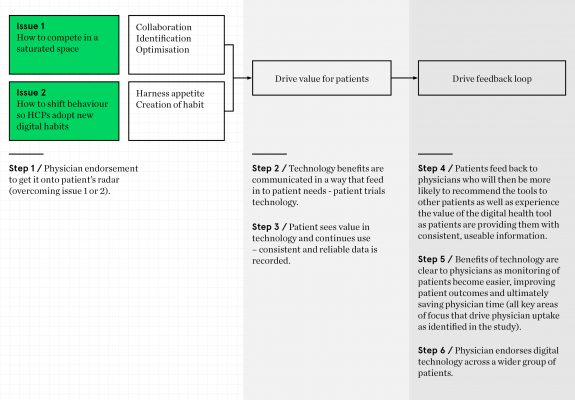By Tessa Brayford, Associate and Dr Pamela Walker
Our first article looked at the appetite, satisfaction and barriers to use of current digital health tools amongst physicians, as identified in a recent survey by Incite. Two critical issues emerged from this insight regarding what a pharma company must consider when entering the digital health space:
- In a heavily saturated therapeutic area (digitally-speaking), how can new kit win ‘share of fingertips’?
- In a digitally quiet therapeutic area, how can pharma find out what really makes HCPs (Health Care Professionals) and patients tick as well as creating a new behaviour around the use of technology?
Clearly, pharma companies need to consider the context of the therapeutic area to maximise opportunities for digital health tools. How companies can best approach this, requires a six-step process and feedback loop to ultimately identify where pharma should play, and how to win in the digital health tools arena.
Issue 1: How do we compete in a saturated space?
The challenge: Digital health tools haven’t just cropped up overnight and some therapy areas are ahead of the wider health curve on this front. As such, we see evidence of potential saturation in these markets, and relatively high satisfaction with current offerings.
Digital health kit can range from wearables enabling patients to better manage their diseases, to offering remote monitoring devices for patients to complete blood tests at home (a prerequisite to patients receiving a cycle of chemotherapy), to artificial intelligence tools. All of these digital support options have the benefit of speeding up personalised care. As ever, when one digs deeper, there remains unmet needs from a patient standpoint. In the area of Oncology and cancer treatment, the majority of specialists in the survey above highlighted that many patients do not see the benefit of digital health tools. This is undoubtedly a barrier to use.
The solution: To create impact, pharma must work alongside HCPs, to collaborate and optimise current offerings in an already competitive space. Developing frameworks that identify the key challenges (ease of use being a significant barrier identified in the Incite survey) across current tools and what areas new technology must address to ensure uptake, is a critical step. Alongside optimised offerings, it is important to focus communications on the patient benefits of digital health tools. Looking at patient behaviours within a given disease area can help to determine how to make the benefits clear, tangible and meaningful to motivate patients to use.
Issue 2: How do we shift behaviour so that HCPs and patients adopt new digital habits?
The challenge: Another significant challenge that a pharma company may face when looking in to digital health tools, is gaining traction within specialities that have been (to this point) left behind in the digital health surge.
Within such specialities, it is important for pharma companies to consider how well HCPs may know what they want from digital technology. Our survey identified cardiologists (heart specialists) as having low satisfaction with existing tools, with less than half satisfied. Equally, there is evidence that cardiologists are hungry for more, with over 80% believing digital health tools will be a standard offering in the future for patients. With this low satisfaction, visibility of current digital health tools may be low, and HCPs may lack experience in using these in their daily practice.
The solution: To create impact, pharma must provide more extensive guidance to HCPs. Opportunity exists to utilise behaviour change principles, such as cognitive ease, to enable HCPs to process the use of the new tools and embed digital health tools into practice for physicians. One such way, would be identifying patients that HCPs should trial new technology with, providing simple steps to improve ease of use and embed use of the tool as a habit. When considering behavioural shifts such as this, it is important for companies to clearly identify and articulate the benefits digital tools can provide, whilst recognising that default practices and engrained behaviour may need to be changed to embed new habits.
Driving Value Through Patient Engagement
Once an offer is in place for physicians, it’s hugely important to drive value for patients. Our survey identified that across specialities, there is a need to support patients in seeing the value of digital health tech – with lack of patient incentive and lack of perceived benefits for patients being large barriers to uptake of current offerings.
To onboard patients, pharma companies must communicate in a way that speaks to what is most relevant and important to specific patient types whilst covering core emotional aspects identified in the Incite survey; desire to have greater control and feel more knowledgeable.
Looking Ahead: The Feedback Loop
By embedding new technology with patients, pharma companies can dramatically benefit from implementing a feedback loop to provide greater longevity to their offer. Such a feedback loop should consider the following six steps:

Creating a feedback loop such as the one above, whilst simple, can only be achieved through patient motivation and commitment to using the digital technology alongside HCP endorsement of a given tool. This feedback loop is key to ensuring digital health technology doesn’t fall into the curse of being abandoned after one use, but instead benefits from the eight + hours people spend on digital technology each day[i].
By Tessa Brayford, Associate and Dr Pamela Walker, Head of Health, Incite
[i] https://www.bbc.co.uk/news/technology-28677674


